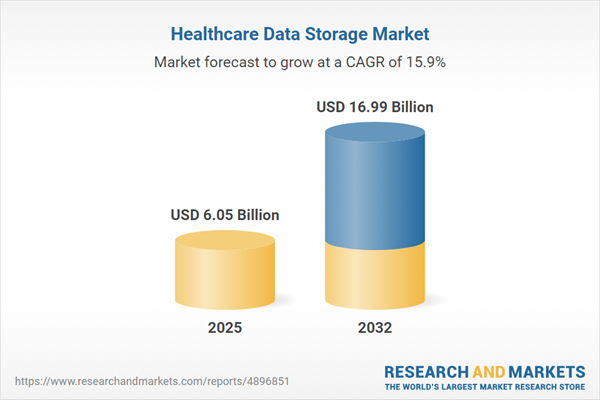Speak directly to the analyst to clarify any post sales queries you may have.
The healthcare data storage market is rapidly transforming as healthcare organizations expand digital infrastructure and manage increasingly complex patient information. Innovative storage solutions are now critical for secure, scalable management of sensitive data across clinical and research environments.
Market Snapshot: Healthcare Data Storage Market
The Healthcare Data Storage Market advanced from USD 5.22 billion in 2024 to USD 6.05 billion in 2025. Propelled by a robust CAGR of 15.87%, the market is forecast to reach USD 16.99 billion by 2032. Organizations are investing in architectures that support performance, compliance, and cost-efficiency as digital health initiatives grow across hospitals, clinics, and research centers.
Scope & Segmentation
- Deployment Mode: Cloud, Hybrid, On-Premise
- Component: Hardware (Backup Tapes, Servers, Storage Arrays), Services (Consulting, Implementation, Maintenance & Support), Software (Analytics, Archiving, Data Management)
- Storage Type: Hard Disk Drive, Solid State Drive, Tape
- Application: Clinical Analytics, Electronic Health Records, Health Information Exchange, Picture Archiving and Communication Systems, Telemedicine
- End User: Clinics, Diagnostic Centers, Hospitals, Research Organizations
- Regional Coverage: Americas (United States, Canada, Mexico, Brazil, Argentina, Chile, Colombia, Peru), Europe (United Kingdom, Germany, France, Russia, Italy, Spain, Netherlands, Sweden, Poland, Switzerland), Middle East (United Arab Emirates, Saudi Arabia, Qatar, Turkey, Israel), Africa (South Africa, Nigeria, Egypt, Kenya), Asia-Pacific (China, India, Japan, Australia, South Korea, Indonesia, Thailand, Malaysia, Singapore, Taiwan)
- Key Companies: Amazon Web Services, Dell Technologies, Microsoft, Hewlett Packard Enterprise, Google, NetApp, IBM, Hitachi Vantara, Oracle, Pure Storage
Key Takeaways for Senior Decision-Makers
- Modern healthcare data storage solutions increasingly integrate advanced analytics and machine learning to support population health management, operational efficiency, and secure patient care workflows.
- Hybrid and cloud-based storage approaches are favored for balancing scalability with regulatory compliance, while on-premise systems remain important for sensitive data needing strict data residency.
- Adoption of technologies such as software-defined storage, deduplication, and encryption is central to building resilient storage architectures adaptable to legacy and next-generation use cases.
- Regional regulatory requirements, such as GDPR in Europe, drive demand for localized and interoperable storage platforms, with substantial public and private investment varying by geography.
- Procurement strategies are evolving in response to geopolitical factors and supply chain challenges, favoring long-term vendor partnerships, modular architectures, and cost-control mechanisms.
Tariff Impact on Storage Infrastructure
Upcoming tariff adjustments in the United States for 2025 are prompting providers and suppliers to reexamine their acquisition and supply chain strategies. Revised duties on storage hardware are shifting budgetary considerations and encouraging partnerships with local manufacturers. Organizations are now assessing options such as hybrid purchasing, renegotiation of vendor contracts, and software-defined solutions to minimize exposure to potential cost increases. These changes underscore the importance of flexibility and risk management in infrastructure planning.
Methodology & Data Sources
This report delivers actionable insights by synthesizing primary interviews with senior IT leaders, clinical informaticists, and data governance experts, as well as extensive secondary research from regulatory filings, technical whitepapers, and peer-reviewed publications. Analytical frameworks, including PESTLE and Porter’s Five Forces, underpin the rigorous validation and interpretation of trends and market drivers.
Why This Report Matters
- Clarifies essential growth strategies and technology trends shaping the healthcare data storage market for senior executives and IT leaders.
- Provides in-depth understanding of regional dynamics and compliance implications vital for successful infrastructure investments and long-term planning.
- Equips stakeholders with strategic insights for optimizing data storage performance, security, and cost-management in evolving healthcare environments.
Conclusion
Advanced, secure, and agile healthcare data storage solutions are foundational for digital transformation, analytics, and patient-centered care. Strategic investment in scalable architectures empowers organizations to address operational, regulatory, and technological challenges—enabling innovation and sustainable growth.
Additional Product Information:
- Purchase of this report includes 1 year online access with quarterly updates.
- This report can be updated on request. Please contact our Customer Experience team using the Ask a Question widget on our website.
Table of Contents
3. Executive Summary
4. Market Overview
7. Cumulative Impact of Artificial Intelligence 2025
Companies Mentioned
The companies profiled in this Healthcare Data Storage market report include:- Amazon Web Services, Inc.
- Dell Technologies Inc.
- Microsoft Corporation
- Hewlett Packard Enterprise Company
- Google LLC
- NetApp, Inc.
- International Business Machines Corporation
- Hitachi Vantara Corporation
- Oracle Corporation
- Pure Storage, Inc.
Table Information
| Report Attribute | Details |
|---|---|
| No. of Pages | 197 |
| Published | November 2025 |
| Forecast Period | 2025 - 2032 |
| Estimated Market Value ( USD | $ 6.05 Billion |
| Forecasted Market Value ( USD | $ 16.99 Billion |
| Compound Annual Growth Rate | 15.8% |
| Regions Covered | Global |
| No. of Companies Mentioned | 11 |









